Key:cycle_barrier
Jump to navigation
Jump to search
| Description |
|---|
| Classification of types / designs of cycle barriers |
| Group: barriers |
| Used on these elements |
| Requires |
| Status: approved |
| Tools for this tag |
|
The key cycle_barrier=* describes the type or design of a cycle barrier, and must be used in combination with the tag barrier=cycle_barrier. For common values see the table below.
This key describes the layout of the grid elements of a cycle barrier. To describe whether such a barrier can be opened or removed (to allow the passage of e.g. emergency services or winter road maintenance), use cycle_barrier:installation=*.
To determine the passability of cycle barriers more precisely, precise size measurements can be added. Which of these are necessary depends on the type/design of the barrier. The following table shows these dimensions depending on the type/design of the cycle barrier.
Common values
| cycle_barrier=* | Picture | Schematic illustration | Description | Dimensions necessary to determine passability |
|---|---|---|---|---|
| single | 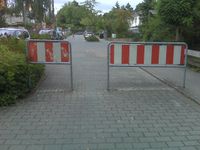 |
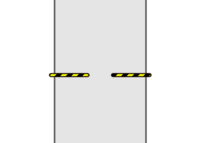 |
A barrier across the path with a passage where you don't have to go around a chicane. Depending on width it may be easily passable while riding, require dismounting or completely block passage - what depends also on bicycle width. | maxwidth:physical=* |
| double |  |
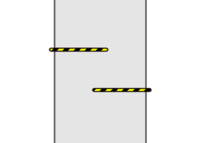 |
A chicane barrier across the path formed by two barriers/bars one behind the other. | spacing=* opening=* (only the smallest of the two) overlap=* |
| triple | 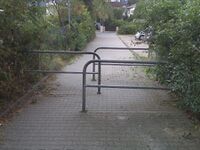 |
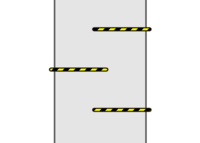 |
A barrier across the path shaped as a multiple chicane, usually formed by three barriers/bars in a row. | spacing=* (only the smallest of the two) opening=* (only the smallest of the three) overlap=* (only the widest of the two, if different) |
| diagonal |  |
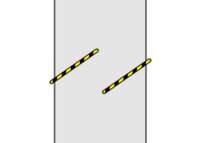 |
Barrier whose bars/elements are arranged at an angle and can - depending on the spacing of the bars/elements - therefore often be passed more easily and with less loss of speed, e.g. with bicycles. | maxwidth:physical=* is usually sufficient. Use deflection=* to indicate the angle (in degrees) you have to deflect from the direction of travel/line of the path to pass through the barrier. |
| tilted |  |
 |
Tilted vertically arranged barrier elements that allow a rather narrow passage. Defining feature is a tilted barrier. Typically narrower than single, and greater barrier but it is possible that very narrow single will block passage in the same way[1]. Called "A-frame"[2] or "K-frame"[3] Originally used squeeze[4] | maxwidth:physical=*, measured at a height of 1 m (= about the height of a bicycle handlebar). Consider using both tilt=* indicating the tilting angle of the barrier elements and height=* for their maximum height to derive the widths at different heights. |
See also
- bollard=* - Finer-grained classification of a bollard
References
- ↑ https://wiki.openstreetmap.org/wiki/Talk:Proposed_features/Advanced_cycle_barrier_tagging#single_vs_squeeze
- ↑ http://www.kbarriers.co.uk/a-frame-barrier/ https://www.cycling-embassy.org.uk/dictionary/access-barrier
- ↑ https://www.cycling-embassy.org.uk/dictionary/access-barrier http://www.kbarriers.co.uk/barrier-type/
- ↑ https://wiki.openstreetmap.org/wiki/Proposed_features/Advanced_cycle_barrier_tagging https://lists.openstreetmap.org/pipermail/tagging/2021-October/062675.html https://wiki.openstreetmap.org/wiki/Talk:Proposed_features/Advanced_cycle_barrier_tagging#single_vs_squeeze